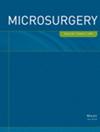Tactile Sensory Recovery in Neurotized Versus Non-Neurotized Autologous Breast Reconstruction: A Systematic Review and Meta-Analysis
Abstract
Background
Tactile sensory recovery in autologous breast reconstruction (ABR) has been shown to prevent injuries and improve quality of life. However, the studies comparing neurotized versus non-neurotized outcomes are still controversial due to methodological heterogeneity. This review uses consistent and objective outcomes to evaluate the current evidence's qualitative characteristics and quantitative tactile sensory recovery.
Methods
We conducted a systematic electronic literature search from database inception through 10 February 2024, of the following databases: PubMed, Ovid MEDLINE, Embase, SCOPUS, and CINAHL to identify all studies reporting outcomes of tactile sensory recovery using the Semmes-Weinstein Measuring scale in free-flap ABR comparing neurotization versus non-neurotization. The SWM scale score, demographic characteristics, and surgical features were extracted from each study. Due to the data heterogeneity within the studies, we transformed the data into means and pooled the qualitative information.
Results
We identified 264 articles. After thorough screening, 12 fulfilled the inclusion criteria and were included in the qualitative synthesis. Finally, 7 were quantitatively analyzed with a total of 251 breasts that underwent ABR with free flap neurotization and 244 breasts without neurotization. This revealed a mean SWM score difference of −0.67 and a significant p-value < 0.05. A subgroup DIEP flap analysis performed for 177 neurotized compared to 175 non-eurotized flaps yielded a significant mean difference of −0.86 p < 0.05. There were no significant differences between groups in age (48.8 vs. 49.8, p = 0.5), history of chemotherapy (72 vs. 74, p = 0.91), radiotherapy (61 vs. 56, p = 0.84), or follow-up time (21.85 vs. 25.09 months, p = < 0.05) that could have influenced tactile sensory recovery.
Conclusion
Neurotization in free-flap ABR could allow better tactile sensory recovery than the spontaneous sensation gained without it. The additional surgical time required for coaptation is short, and no studies have reported associated complications, making it a safe procedure that can potentially improve patients´ quality of life. Nonetheless, higher-quality studies, such as randomized control trials with standardized sensation testing and more rigorous methodologies, are needed before making final clinical recommendations.

 求助内容:
求助内容: 应助结果提醒方式:
应助结果提醒方式:


